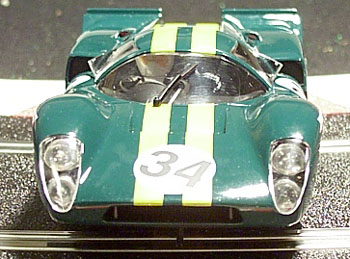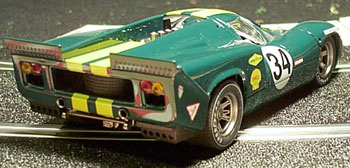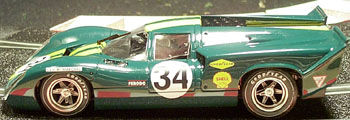 |
| This is one of many Lolas that Fly Car Model produced
in their classic line. Overall it's plainer than some of the others,
but the double stripes up the center give this car great character.
|
 |
| Fly is well known for their attention to detail.
Look in the opening directly between the stripes. Yup, it's
equipped with a full spare! You don't see much of that these days.
It may be a hindrance to optimal performance, but it looks so cool.
|
 
|
| If it weren't for the fact that the car is sitting
on slot car track, I might be able to pass this off as the real thing!
|
 |
| Look how beautiful the lines on this car are!
It pulls light along its body panels to add interest and really
hold your eye.
|
|
My Review: Let me start by saying I don't have any timing software running on my track, which is a small 16' figure 8 (Scalextric Circuit 2). I also remove any traction magnets from my cars to give them the tail hangin' sliding handling I love. This is one of may favorite slot cars (in any scale). I first fell in love with the Lola in the form of a T-Jet (Aurora HO slot car). But since so many guys race that body, I stopped. In 1/32 scale, I fell in love all over again. The Lola has such a unique and graceful countenance with it's smooth lines juxtaposed with its sharp edges. It begs to be driven. The car only has one flaw. It's common in Fly cars: rear axle "slop" (excess side-to-side movement). I was able to remedy that with spare parts from my 1/10 R/C parts bin. A brass servo collar ground down to size was perfect. After that, dab some oil in the right places and I was off and running. I don't know how there is this much difference from car to car, but this Lola is much more powerful than the #9 Sunoco car I have. I was very accustomed to the way that Lola drove with the same sidewinder chassis that's in this green one, but it's a totally different experience. This car has jump-out-of-the-slot power. Gun it in the straight, and you'll end up watching it slide (out of the slot) down the entire length and into the barriers lining the curves. Without a timing system, I use the Scalextric Pacer Unit to run a drone that will turn moderately fast laps. I also set up the Figure 8 to have the short chicane on the over pass instead of under it as the track plan suggests. A minor change with a major effect. The Pacer controls lane 2. From the starting line, lane 2 has the outside lane in the first curve leading to the upper track section. When the straight section starts, there is one standard straight followed by the chicane, and another standard straight. What does that mean? Well, you're driving lane 1, which you must drive slower upto the upper straight, since you are on the inside. Following that, you have the chicane, then you get the outer curve and 4 lengths of standard straights before you have to head up again. Those four sections of straight are almost useless to you since you have to slow down in order to control your car on the inside curve heading upto the upper straight (remember I remove all the magnets from my cars). This means that the best place to pass is on the straight that has the chicane in it or the outside curve that immediately follows. The chicane's issues are quite apparent. Being on the outside of the curve (downhill) means you can't go too fast, but the Pacer car is travelling a much shorted distance in the same section of track. To pass there with no magnetic downforce is almost impossible. But this Lola makes it seem so easy! Getting up on the inside curve and making a move before the chicane is nearly routine! If you can't make it the first time, it'll hold on on the outside, downhill curve and get you back in position to try it again on the next lap. This car is one of my best performing 1/32 slot cars. Beauty and on-track performance...what more can you ask for?!!!! |